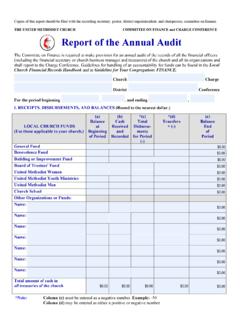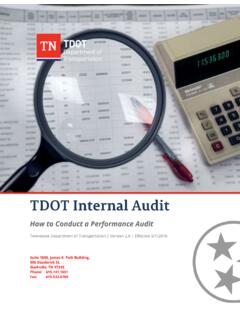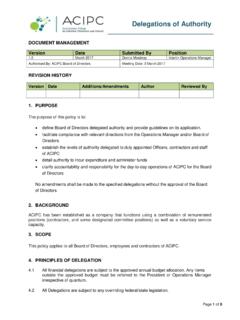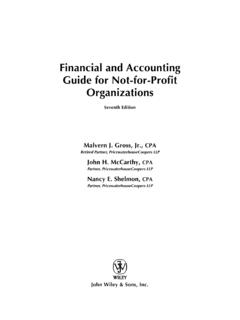Transcription of The Five Percent Minimum Payout Requirement
1 Our thanks to the Council on Foundations for sharing this information with us. These materials do not constitute, nor should they be interpreted as, legal advice. The Association of Baltimore Area Grantmakers and the Council on Foundations do not assume responsibility for any individual s or organization s reliance on these materials. The specific advice of legal counsel is recommended before acting on any matter discussed in this material. The Five Percent Minimum Payout Requirement What is the 5 Percent Payout Requirement ? The purpose behind the Minimum Payout Requirement is to prevent foundations from simply receiving gifts, investing the assets and never spending any funds on charitable purposes. The basic rule can be stated simply, but its calculation is complex: Each year every private foundation must make eligible charitable expenditures that equal or exceed approximately 5 Percent of the value of its endowment. The word " Payout " while convenient is somewhat misleading and is not used in the Tax Code section that creates the rule.
2 The word " Payout " suggests grants or contributions paid out to other charities. Although these grants normally make up more than 93 Percent of the expenditures of most foundations, many other expenses can also qualify in meeting the Minimum Payout Requirement . In short, the 5 Percent Payout rule need not be satisfied solely with grants. What is the penalty for failure to satisfy the rule? The penalty for failure to meet the 5 Percent Minimum is 30 Percent of the shortfall or the remaining amount that should have been spent to meet the required Minimum level. The penalty is on the foundation only and cannot be applied to a foundation manager; however, a state attorney general might charge a manager for the amount of the penalty to replenish the foundation on the theory that the manager failed to exercise his or her fiduciary duty. Within what time period must the 5 Percent be paid out? Private foundations have 12 months after the tax year in question to satisfy the Minimum Payout Requirement .
3 For example, a new foundation could pay out nothing in its initial tax year and satisfy the first year's Minimum by applying the first expenditures in the second year retroactively. Similarly, any foundation can retroactively satisfy last year's Payout Requirement with this year's qualifying payments. Example: A new family foundation is incorporated on April 1, 1998, and opts to complete a shortened first tax year on December 31, 1998 (nine months). The foundation would have 12 extra months until December 31, 1999, to complete its 1998 Payout . Note also that its 1998 Payout will be based on only nine months; average assets will be calculated by adding nine monthly asset totals and dividing by nine and the percentage applied will be 9/12 of 5 Percent (or Percent ). Example: A seven year old family foundation whose tax year ends on June 30 reaches June 30, 1998, $50,000 short of meeting its Payout Requirement . This foundation has until June 30, 1999, to make up the $50,000 shortfall.
4 Normally, a foundation in this condition would make up the $50,000 in the first few months after June 30, 1998, and then start making qualifying distributions that qualify for its tax year that begins July 1, 1998. What counts as a qualifying distribution? The Minimum Payout Requirement can be met by any expenditure that meets the definition of a "qualifying distribution." In short, the law states you must have qualifying distributions equal to approximately 5 Percent , not a " Payout " of 5 Percent . Qualifying distributions are: grants to charities and non-charities for charitable purposes all reasonable administrative expenses necessary for the conduct of the charitable activities of the foundation (see below) costs of all direct charitable activities (see below) amounts paid to acquire assets used directly in carrying out charitable purposes (computers, office furniture, a building to house the foundation). Although purchases of this type are normally amortized, the Form 990-PF tax return permits them to be fully utilized as qualifying distributions in the year paid.
5 Only assets used for the production of income can be depreciated. set-asides (see below) program-related investments. Investment expenses incurred in managing the endowment do not count toward meeting the Minimum Payout Requirement . Examples of investment expenses are investment management fees, brokerage fees, custodial fees, salaries or board meeting expenses to oversee investments. However, investment expenses do count in reducing gross investment income to net investment income to which the 2 Percent (or 1 Percent ) investment tax applies. Which administrative expenses count toward the Payout ? Except for investment management fees noted previously, all administrative expenses count toward the Payout so long as they are necessary and reasonable. After subtracting any portions that should be allocated to investment costs, the following expenses count: salaries, benefits, trustee fees, professional fees, consulting fees, travel expenses, general overhead, training, publications, office supplies (pencils, paper and similar items that are not major assets), telephone, rent, etc.
6 Example of an allocation: The board of Foundation X has a meeting during which 50 Percent of the time is devoted to grantmaking and 50 Percent to overseeing investments; if the costs of the meeting are $1,000 (travel, meals, materials, refreshments), then $500 would count as a charitable expense toward meeting the Payout and $500 would count as an investment expense to reduce gross investment income in calculating the 2 Percent (or 1 Percent ) excise tax. Also, the costs of complying with legal requirements count toward the Payout ; such compliance costs include preparing of tax returns, defending legal matters, obtaining rulings from the IRS, fulfilling state and federal filing requirements and purchasing of a newspaper ad announcing the availability of the tax return for public inspection. The costs of publishing an annual report and obtaining a year-end audit also count toward the Payout . What are direct charitable activities? All expenditures for carrying out a charitable activity of a family foundation in house rather than making a grant to another charity to perform the same activity count toward the Payout as qualifying distributions.
7 Direct charitable activities include running a library or art gallery, performing in house research and publishing the results, providing technical assistance to grantees and potential grantees, serving on the board or committee of another charity (such as the Council on Foundations or a regional association), maintaining a historic site or conducting a conference. Legally, there is no limit to the amount of a foundation's budget that can be spent on direct charitable activities; in general, however, grants constitute 90 to 95 Percent of qualifying distributions. What are set-asides? Set-asides are rarely used because they require advance approval by IRS, but they do count toward the Payout . The foundation must convince the IRS that the specific project to be funded is better funded over multiple years (not more than five) rather than by immediate payment. A typical example is the construction of a building that may take several years from design to final completion.
8 If approval of a set aside is obtained from the IRS, the full amount of the multi-year grant may count toward the Payout in the first year. Because of the technical requirements of set-asides, legal consultation is strongly advised. How is asset size calculated for purposes of the 5 Percent rule? The size of the endowment for purposes of calculating the Payout rule is a 12-month average of the fair market value of the endowment for the tax year in question. The technical term for endowment or assets used by IRS and the Form 990-PF tax return is "non-charitable use assets." Note that the endowment includes only non-charitable use assets (cash, stocks, bonds and other investments). Charitable use assets (or those used in carrying out charitable purposes) do not count in calculating the Payout . Examples of charitable use assets not included in the endowment would be a building that houses the foundation, fixtures and other capital equipment such as desks, furniture or computers.
9 The measurement is not taken at the beginning or the end of the year. A 12-month average allows for fluctuation that occurs in investment markets. The foundation should decide with its accountant and counsel which method of calculating a monthly market value makes sense. The measurement can be taken on the first of the month or the last day of the month or one could take the first and last days and average the values. Virtually any method can be chosen so long as it is reasonable and consistently applied. Once a fair market value is determined for each month, all 12 amounts are added together and divided by 12 to obtain the value to which the 5 Percent applies. If the foundation is new or changing accounting years so that the tax year in question is a partial year, appropriate adjustments should be made. For example, if the tax year is only seven months long, add up seven monthly averages and divide by seven (the Payout will be 7/12 of 5 Percent ). How is the Payout actually calculated?
10 As noted above, determination of the Payout is complex. In fact, there is no clear definition of Payout . There is a clear definition of the "distributable amount," which is the Minimum a foundation must meet to avoid penalty, but the 5 Percent calculation is only one of many that brings you to the final calculation of distributable amount (in most cases, distributable amount will be quite close to 5 Percent ). Once the foundation has calculated the 12-month average fair market value of its endowment, at least two other adjustments are permitted. The law presumes that any foundation needs to have cash on hand to conduct business; thus, the endowment value for the year may be reduced by Percent for "cash deemed held for charitable purposes." Second, after calculating the 5 Percent figure, the foundation may claim a credit against the Payout amount for any taxes paid during the year, namely the 2 Percent (or 1 Percent ) excise tax on investment income. The final figure is called the "distributable amount.





